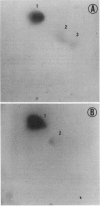Abstract
As starch is the main seed reserve material in both species of Araucaria of South America, A. araucana and A. angustifolia, it is important to understand starch breakdown in both embryo and megagametophyte tissues of Araucaria seeds. Sugar analysis by thin layer chromatography indicates that sucrose is the main sugar produced in both tissues. Enzyme reactions coupled to benzidine oxidation indicate that sucrose is the main sugar moved from the megagametophyte to the growing regions of the embryo via the cotyledons.
Phosphorylase was detected in both embryo and megagametophyte tissues by the formation of [32P]glucose-1-P and by formation of [14C] amylopectin from [14C]glucose-1-P. The enzyme activity increases 5-fold in both embryo and gametophyte to a peak 18 hours after the start of imbibition. Debranching enzyme, α-glucosidase, and hexokinase are also present in both embryonic and megagametophytic tissues.
Branched glucan oligosaccharides accumulate during this time, reaching a maximum 40 hours after imbibition starts, and decline after germination occurs.
The pattern of activity of the enzymes studied in this work suggests that starch degradation is initiated by α-amylase and phosphorylase in the embryo and by phosphorylase mainly in the megagametophyte. Sucrose-P synthase seems to be the enzyme responsible for sucrose synthesis in both tissues.
Full text
PDF







Images in this article
Selected References
These references are in PubMed. This may not be the complete list of references from this article.
- Amir J., Preiss J. Kinetic characterization of spinach leaf sucrose-phosphate synthase. Plant Physiol. 1982 May;69(5):1027–1030. doi: 10.1104/pp.69.5.1027. [DOI] [PMC free article] [PubMed] [Google Scholar]
- BANDURSKI R. S., AXELROD B. The chromatographic identification of some biologically important phosphate esters. J Biol Chem. 1951 Nov;193(1):405–410. [PubMed] [Google Scholar]
- CARDINI C. E., LELOIR L. F., CHIRIBOGA J. The biosynthesis of sucrose. J Biol Chem. 1955 May;214(1):149–155. [PubMed] [Google Scholar]
- Feige B., Gimmler H., Jeschke W. D., Simonis W. Eine Methode zur dünnschichtchromatographischen Auftrennung von 14C- und 32P-markierten Stoffwechselprodukten. J Chromatogr. 1969 Apr 22;41(1):80–90. doi: 10.1016/0021-9673(64)80099-6. [DOI] [PubMed] [Google Scholar]
- Juliano B. O., Varner J. E. Enzymic degradiation of starch granules in the cotyledons of germinating peas. Plant Physiol. 1969 Jun;44(6):886–892. doi: 10.1104/pp.44.6.886. [DOI] [PMC free article] [PubMed] [Google Scholar]
- LELOIR L. F., CARDINI C. E. The biosynthesis of sucrose phosphate. J Biol Chem. 1955 May;214(1):157–165. [PubMed] [Google Scholar]
- Swain R. R., Dekker E. E. Seed germination studies. I. Purification and properties of an alpha-amylase from the cotyledons of germinating peas. Biochim Biophys Acta. 1966 Jul 6;122(1):75–86. doi: 10.1016/0926-6593(66)90092-0. [DOI] [PubMed] [Google Scholar]
- Swain R. R., Dekker E. E. Seed germination studies. II. Pathways for starch degradation in germinating pea seedlings. Biochim Biophys Acta. 1966 Jul 6;122(1):87–100. doi: 10.1016/0926-6593(66)90093-2. [DOI] [PubMed] [Google Scholar]
- Szepesi B., Freedland R. A. Time-course of enzyme adaptation. I. Effects of substituting dietary glucose and fructose at constant concentrations of dietary protein. Can J Biochem. 1968 Dec;46(12):1459–1470. doi: 10.1139/o68-218. [DOI] [PubMed] [Google Scholar]




